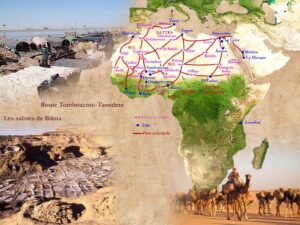For a long time, it was thought that the African continent had no metallurgical traditions prior to Phoenician colonisation (around 1100 BC), and that the sub-Saharan areas remained tied to the Neolithic way of life.
In terms of the full range of ancient African cultures, the only exception has been the civilisation of ancient Egypt, whose influence did not extend far into Africa beyond the reach of the Nile.
However, traces of ironworking have been found in West Africa, and copper artefacts from the 4th century BC found in Egypt and Nubia suggest that the trans-Saharan route was already known and travelled.
Recent discoveries document an early production of metal artefacts in many areas of West Africa, particularly in sub-Saharan regions. The earliest evidence has been found in eastern Niger, where the Termite people knew the techniques of iron metallurgy as early as 1500 BC.
It is thought that this technology, together with that of copper working, spread from north to south as far as the Cape of Good Hope. With this knowledge, the Bantu-speaking peoples became the largest producers of iron for tools and weapons in southern Africa from 200 AD.
Iron smelting furnaces have been documented at Taruga in Nigeria as early as 750 BC; there is evidence of ancient iron production at many sites in Cameroon, with furnaces, coal storage pits, anvils and fragments of iron artefacts dating from 2343/2058 BC to 2135/1921 BC. The same metal was used by the Gabonese as early as the 1st millennium BC.
The richest and oldest gold mines are in southern Africa and appear to have been exploited as early as the 1st millennium BC. In particular, the oldest gold mines are in southern Zimbabwe. Zulu legends tell us that they were worked by ‘man-made flesh and blood slaves created by the First People’ who ‘went into battle with the Man-Ape’ when ‘the great star war appeared in the sky’

